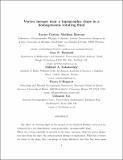Files in this item
Vortex merger near a topographic slope in a homogeneous rotating fluid
Item metadata
| dc.contributor.author | Carton, Xavier | |
| dc.contributor.author | Morvan, Mathieu | |
| dc.contributor.author | Reinaud, Jean Noel | |
| dc.contributor.author | Sokolovskiy, Mikhail | |
| dc.contributor.author | L'Hégaret, Pierre | |
| dc.contributor.author | Vic, Clément | |
| dc.date.accessioned | 2017-10-02T09:30:17Z | |
| dc.date.available | 2017-10-02T09:30:17Z | |
| dc.date.issued | 2017-10-01 | |
| dc.identifier | 251040791 | |
| dc.identifier | 8f61959c-54f7-4a79-863a-ef50128fb458 | |
| dc.identifier | 85030178953 | |
| dc.identifier | 000412030900001 | |
| dc.identifier.citation | Carton , X , Morvan , M , Reinaud , J N , Sokolovskiy , M , L'Hégaret , P & Vic , C 2017 , ' Vortex merger near a topographic slope in a homogeneous rotating fluid ' , Regular and Chaotic Dynamics , vol. 22 , no. 5 , pp. 455-478 . https://doi.org/10.1134/S156035471705001X | en |
| dc.identifier.issn | 1560-3547 | |
| dc.identifier.other | ORCID: /0000-0001-5449-6628/work/37255567 | |
| dc.identifier.uri | https://hdl.handle.net/10023/11779 | |
| dc.description | This work is a contribution to the PHYSINDIEN research program. It was supported by CNRS-RFBR contract PRC 1069/16-55-150001. | en |
| dc.description.abstract | The effect of a bottom slope on the merger of two identical Rankine vortices is investigated in a two dimensional, quasi-geostrophic, incompressible fluid. When two cyclones initially lie parallel to the slope, and more than two vortex diameters away from the slope, the critical merger distance is unchanged. When the cyclones are closer to the slope, they can merge at larger distances, but they lose more mass into filaments, thus weakening the efficiency of merger. Several effects account for this: the topographic Rossby wave advects the cyclones, reduces their mutual distance and deforms them. This along shelf wave breaks into filaments and into secondary vortices which shear out the initial cyclones. The global motion of fluid towards the shallow domain and the erosion of the two cyclones are confirmed by the evolution of particles seeded both in the cyclone sand near the topographic slope. The addition of tracer to the flow indicates that diffusion is ballistic at early times. For two anticyclones, merger is also facilitated because one vortex is ejected offshore towards the other, via coupling with a topographic cyclone. Again two anticyclones can merge at large distance but they are eroded in the process. Finally, for taller topographies, the critical merger distance is again increased and the topographic influence can scatter or completely erode one of the two initial cyclones. Conclusions are drawn on possible improvements of the model configuration for an application to the ocean. | |
| dc.format.extent | 1774007 | |
| dc.language.iso | eng | |
| dc.relation.ispartof | Regular and Chaotic Dynamics | en |
| dc.subject | Two-dimensional incompressible flow | en |
| dc.subject | Vortex merger | en |
| dc.subject | Critical merger distance | en |
| dc.subject | Bottom slope | en |
| dc.subject | Topographic wave and vortices | en |
| dc.subject | Diffusion | en |
| dc.subject | QA Mathematics | en |
| dc.subject | QC Physics | en |
| dc.subject | NDAS | en |
| dc.subject.lcc | QA | en |
| dc.subject.lcc | QC | en |
| dc.title | Vortex merger near a topographic slope in a homogeneous rotating fluid | en |
| dc.type | Journal article | en |
| dc.contributor.institution | University of St Andrews. Applied Mathematics | en |
| dc.contributor.institution | University of St Andrews. Scottish Oceans Institute | en |
| dc.identifier.doi | 10.1134/S156035471705001X | |
| dc.description.status | Peer reviewed | en |
This item appears in the following Collection(s)
Items in the St Andrews Research Repository are protected by copyright, with all rights reserved, unless otherwise indicated.

